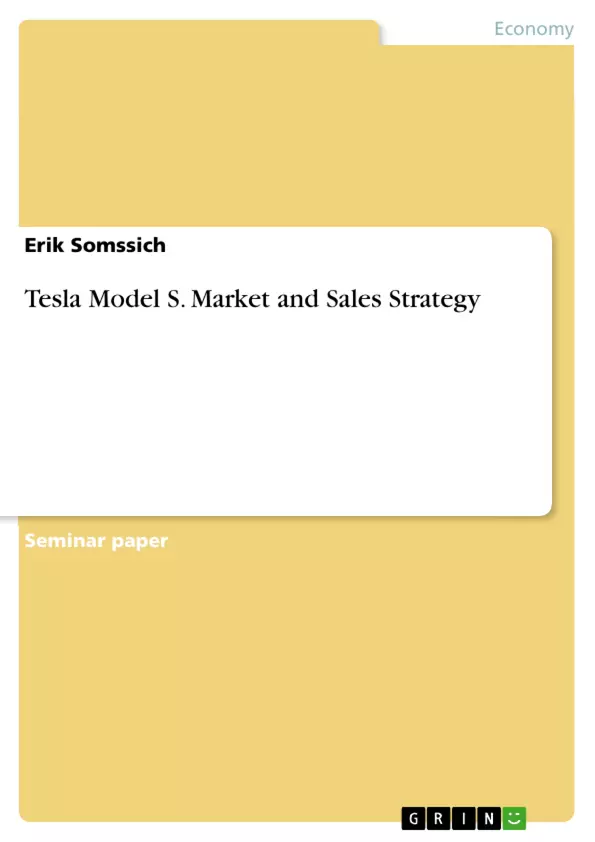The purpose of this assignment was to analyze the market and sales strategy of Tesla and to identify its Model 3 customers.
After ten years of waiting, Tesla's CEO Elon Musk has presented Tesla Model 3 to the public for the first time in an evening show at the end of march 2016. Unveiled at the company's design studio in Hawthorne, California in front of a crowd of whooping and cheering customers and journalists, Model 3 is the most affordable Tesla so far, hoped to bring electric cars to the mass market. Musk stated that the car will deliver at least 215 miles of range beginning at just 35.000 dollar. Musk is "fairly confident" that deliveries will begin by the end of 2017, and "you will not be able to buy a better car for 35.000 dollar, even with no options." Also it will be one of the safest cars in the world, according to Musk. Even before Tesla unveiled its new middle-class model, there were more than 115,000 people who had paid already 1.000 dollar to reserve one of the highly-anticipated electric cars. These early buyers didn't know what the car would look like or that it would have a starting price of exactly 35.000 dollar. They also didn't know how long the production and delivery would take.
Table of Contents
- Introduction
- Marketing Mix Tesla
- Product Customer Value
- Price / Cost
- Place/Convenience
- Promotion/Communication
- Conclusions
Objectives and Key Themes
The objective of this paper is to analyze Tesla's successful market and sales strategy for the Model 3, focusing on the customers who pre-ordered the car despite the long wait time and lack of complete information. The analysis utilizes various media and social media sources due to the unavailability of dedicated customer studies on this recent topic.
- Tesla's Marketing Mix for Model 3
- Analysis of Customer Behavior and Pre-orders
- Tesla's Competitive Advantage in the Electric Vehicle Market
- The Role of Brand Image and Hype in Sales Success
- Challenges and Future Prospects for Tesla's Model 3
Chapter Summaries
Introduction: This chapter introduces Tesla's Model 3, highlighting its significance as Tesla's most affordable car aimed at the mass market. It emphasizes the unusual hype surrounding the car, with numerous pre-orders placed even before its official unveiling, and the substantial waiting period until delivery. The chapter establishes the study's purpose: to analyze Tesla's marketing strategy and the behavior of its early adopters. The challenges in conducting research due to the recency of the Model 3 launch are also addressed.
Marketing Mix Tesla: This chapter delves into the marketing mix applied by Tesla for the Model 3. It explains the concept of the marketing mix and its adaptation by Kotler into the 4Cs: Customer Value, Cost, Convenience, and Communication. The chapter sets the stage for a detailed examination of each element within the context of the Model 3's launch and marketing.
Keywords
Tesla Model 3, Marketing Mix, Electric Vehicles, Customer Value, Brand Image, Pre-orders, Market Strategy, Hype, Sales Success, Early Adopters.
Tesla Model 3 Marketing Strategy: Frequently Asked Questions
What is the purpose of this document?
This document provides a comprehensive preview of an analysis of Tesla's marketing strategy for the Model 3, focusing on the reasons behind its successful pre-orders despite long wait times and limited information. It includes a table of contents, objectives, key themes, chapter summaries, and keywords.
What are the key themes explored in this analysis?
The analysis explores Tesla's marketing mix for the Model 3, focusing on customer behavior and pre-orders, Tesla's competitive advantage in the electric vehicle market, the role of brand image and hype, and the challenges and future prospects for the Model 3.
What is the scope of the analysis regarding Tesla's marketing mix?
The analysis examines Tesla's marketing mix using Kotler's 4Cs: Customer Value, Cost, Convenience, and Communication, applying these concepts to the specific context of the Model 3's launch and marketing campaign.
Why was the analysis of pre-orders important?
The high number of pre-orders for the Model 3, despite the long wait times and incomplete information, presented a unique opportunity to analyze Tesla's successful market strategy and the behavior of early adopters.
What challenges were faced in conducting this research?
The recency of the Model 3 launch posed challenges in conducting research, as dedicated customer studies on this topic were unavailable. The analysis relied on various media and social media sources to gather information.
What are the key chapters covered in the analysis?
The analysis includes an introduction, a detailed examination of Tesla's marketing mix for the Model 3, and concluding remarks. Each chapter provides a specific focus on different aspects of Tesla's strategy and the customer response.
What are some of the key words associated with this analysis?
Key words include: Tesla Model 3, Marketing Mix, Electric Vehicles, Customer Value, Brand Image, Pre-orders, Market Strategy, Hype, Sales Success, and Early Adopters.
- Quote paper
- Erik Somssich (Author), 2016, Tesla Model S. Market and Sales Strategy, Munich, GRIN Verlag, https://www.grin.com/document/356696



